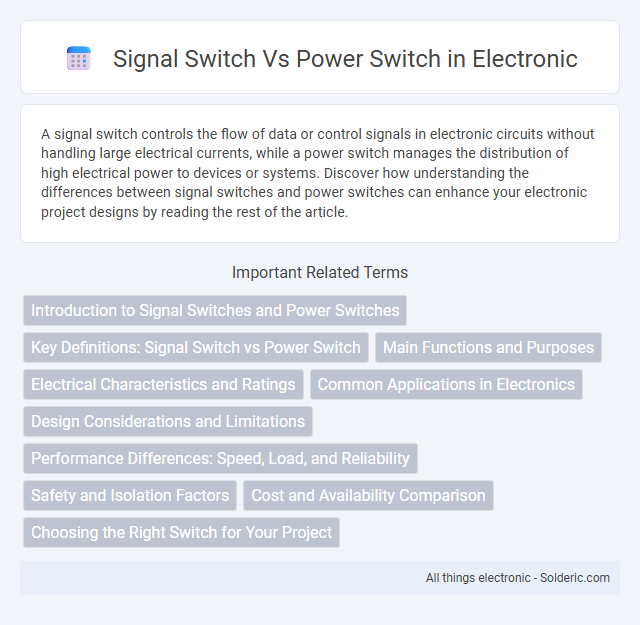A signal switch controls the flow of data or control signals in electronic circuits without handling large electrical currents, while a power switch manages the distribution of high electrical power to devices or systems. Discover how understanding the differences between signal switches and power switches can enhance your electronic project designs by reading the rest of the article.
Comparison Table
| Feature | Signal Switch | Power Switch |
|---|---|---|
| Purpose | Controls low voltage signal circuits | Controls high voltage/current power circuits |
| Current Rating | Typically milliamps to a few amps | Handles high current, up to hundreds of amps |
| Voltage Rating | Low voltage, usually under 50V | High voltage, usually 120V and above |
| Contact Type | Delicate, low power contacts | Robust, heavy duty contacts |
| Common Applications | Audio, telecommunications, control signals | Household appliances, industrial machinery |
| Switching Speed | Fast switching possible | Slower switching to handle power safely |
| Size | Compact and small | Usually larger and more robust |
| Durability | Lower mechanical strength | High durability and mechanical strength |
Introduction to Signal Switches and Power Switches
Signal switches control low voltage or low current signals within electronic circuits, often used in communication and data routing applications to manage information flow without interrupting power supply. Power switches handle higher voltage and current loads, primarily designed to control energy flow to devices, offering protection and efficient power management in electrical systems. Both types of switches are crucial components in electronics and electrical engineering, serving distinct roles based on their voltage and current handling capabilities.
Key Definitions: Signal Switch vs Power Switch
A signal switch is designed to control low voltage and low current signals within electronic circuits, enabling data or communication paths without handling high power loads. In contrast, a power switch manages higher voltage and current levels, often used to turn on or off electrical power to devices or systems. Understanding the distinction centers on their operational capacity: signal switches focus on signal integrity and low power control, while power switches prioritize safe and efficient power distribution.
Main Functions and Purposes
Signal switches control the flow of electronic signals in circuits, enabling the routing and switching of low-power data or communication signals without interrupting the circuit operation. Power switches handle the distribution and control of electrical power, managing higher currents and voltages to turn devices or systems on and off safely. Understanding the distinction helps you select the appropriate switch type to optimize system performance and reliability.
Electrical Characteristics and Ratings
Signal switches typically handle low voltage and current levels, often below 30V and 1A, designed for precise, low-power signal routing with minimal distortion and crosstalk. Power switches are engineered for higher voltage and current, commonly exceeding 100V and 10A, to control large loads and manage electrical power efficiently with robust thermal and short-circuit protections. The electrical ratings of signal switches prioritize low on-resistance and low leakage current, whereas power switches emphasize high breakdown voltage, high current carrying capacity, and durability under heavy load conditions.
Common Applications in Electronics
Signal switches are commonly used in low-voltage applications such as audio routing, RF circuits, and sensor signal selection, where precise control of small currents is essential. Power switches handle higher currents and voltages, making them ideal for motor control, power distribution, and lighting systems. Both types of switches are integral to electronic circuit design, ensuring efficient management of signal integrity and power delivery.
Design Considerations and Limitations
Signal switches require careful attention to parameters like insertion loss, isolation, and bandwidth to maintain signal integrity in low-voltage, high-frequency applications. Power switches demand robust thermal management, current carrying capacity, and voltage ratings to handle high power loads without degradation or failure. Design limitations include signal switches' susceptibility to noise and crosstalk, while power switches face challenges such as heat dissipation and mechanical wear under heavy load conditions.
Performance Differences: Speed, Load, and Reliability
Signal switches typically offer faster switching speeds and lower load capacity compared to power switches, which are designed to handle higher current and voltage levels with greater robustness. Power switches prioritize reliability and durability to manage heavy electrical loads, often resulting in slower switching performance due to increased contact materials and construction. The choice between signal and power switches depends on the specific application requirements, balancing speed, load capacity, and long-term operational reliability.
Safety and Isolation Factors
Signal switches provide isolation by handling low voltage and current levels, minimizing the risk of electric shock and protecting sensitive circuits from interference or damage. Power switches manage higher voltages and currents, requiring robust insulation and safety mechanisms to prevent electrical hazards and ensure user protection. Your choice between signal and power switches significantly influences system safety and isolation effectiveness based on the application's voltage and current demands.
Cost and Availability Comparison
Signal switches generally cost less and are more widely available due to simpler construction and common usage in low-power applications. Power switches tend to be more expensive because they require robust materials and designs to handle higher currents and voltages safely. Availability of power switches may be limited to specialized suppliers, whereas signal switches can be sourced from a broad range of distributors.
Choosing the Right Switch for Your Project
Choosing the right switch for your project depends on the type of current and voltage involved; signal switches are designed for low-level signals, ensuring minimal interference and high precision in data transmission. Power switches handle higher currents and voltages, making them ideal for controlling electrical devices and appliances with robust safety features. Evaluating load requirements, switching speed, and isolation is critical to selecting the appropriate switch for optimal performance and reliability.
signal switch vs power switch Infographic

 solderic.com
solderic.com